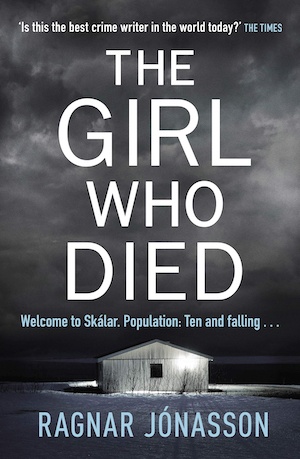
Translated by Victoria Cribb — 2020 was a year of lasts for Icelandic crime writer Ragnar Jónasson. The Mist, the third in the Hidden Iceland trilogy, as well as Winterkill, the final Ari Thór novel, were released the midst of the pandemic. Instead of diving straight back with a new series, with The Girl Who Died Ragnar has brought out a standalone. His past successes have set a high bar – can he reach it once again?
Unlike the author’s previous works, The Girl Who Died doesn’t have a police officer as protagonist and there’s no official investigation into a murder or crime either. Instead we have Una, a teacher from Reykjavik, who arrives in the small, remote town of Skálar located on the Langanes Peninsula in Northern Iceland. With a population of only 10, Skálar is the perfect setting for a closed circle crime mystery and given Ragnar’s interest in Agatha Christie it should come as no surprise that he chose this location.
When Una sees an advertisement for a teaching position ‘on the edge of the world’ she’s intrigued. Living in Reykjavik on a teacher’s salary is a challenge and her strained relationship with her mother makes a change of scenery all the more appealing. What Una doesn’t take into consideration is the sheer animosity she will encounter once she arrives in the town. Skálar is a close-knit community. Secrets are hidden for generations and locals protect each other, whatever the cost. If Salka hadn’t convinced the local council that her daughter, Edda, and the only other girl in the village, Kolbrún, needed a teacher, Una would never have been allowed in the community.
Among her teaching duties is organising the annual Christmas concert where the two girls are to perform. With the help of the interfering Gudrun, arrangements are going smoothly but on the night a shocking event disturbs what would have been a highlight on the town’s social calendar. Another stranger visiting the town goes missing. After knocking on Salka’s door looking for Hjördís’ farm, Patrekur Kristjánsson was last seen three days before Christmas and the timeline matches up with the stranger who showed up on their doorstep. Una doesn’t realise this until some time later due to the lack of television and delay in receiving recent newspapers. However, she starts poking around.
As if this isn’t enough drama and intrigue to contend with there appears to be a ghost in the attic Una rents. She is repeatedly woken up by the chilling sound of a girl singing a lullaby, but when she broaches the subject with Salka, the woman remains tight-lipped. Is it just her imagination or are the psychological effects of the extreme isolation taking their toll? To cope, Una starts drinking wine from the local shop. In a small village, details like this don’t go unnoticed and when she starts to ask questions about both the ghostly girl and the missing man, her drinking habits are a convenient excuse for silence among the locals. After all who can take a semi-alcoholic with an overactive imagination seriously?
Despite her attempts to fit in, Una can’t shake the feeling that the town is closely guarding a secret and sees her as a threat. The idea of being watched leaves her with an ominous sense of dread, as if nowhere is safe. The malevolence of the town’s people, her haunted attic and the equally hostile environment with its bleak, dark and dreary weather is hardly conducive to her mental wellbeing and eventually she starts to question her sanity.
Fortunately there’s Thór, who rents a room on the farm from Hjördís. Thór is not a local either and Una feels safe confiding in him and he’s too happy to provide a shoulder to cry on. He also divulges more about the girl named Thrá who died in the house in 1927 under mysterious circumstances. But when she asks him about Patrekur Kristjánsson he confirms that the man left the farm the next morning and he hasn’t seen him since.
The Girl Who Died starts off at a slow pace, nothing dramatic happens and there are no bodies in the first chapter. Yet, this is what one expects from this type of mystery. Instead of drama there’s a consistent, gradual build-up of tension and for most of the novel we and Una are kept entirely in the dark. There aren’t any clues to unravel and for the enthusiastic mystery reader there won’t even be grounds for speculation. Which might be a good thing – at least the plot’s not predictable.
As always Ragnar Jónasson excels at creating the gloomy, ominous and bone-chilling atmosphere he’s known for. Skálar certainly is the perfect spot for a murder. That is, if there ever was one… At times the accent on the feeling of being watched, the frosty villagers, Una’s alcohol habit and how alone she feels becomes repetitive.
Overall this latest stand-alone doesn’t quite hit the mark in the same way as the Hidden Iceland trilogy. There is the supernatural element, but even though the little girl’s death has similarities with another incident, it’s not essential to the plot. If you enjoy slow-paced crime fiction which isn’t driven by a strong narrative, but has plenty of atmosphere, this is the book for you.
Michael Joseph
Print/Kindle/iBook
£10.69
CFL Rating: 3 Stars








